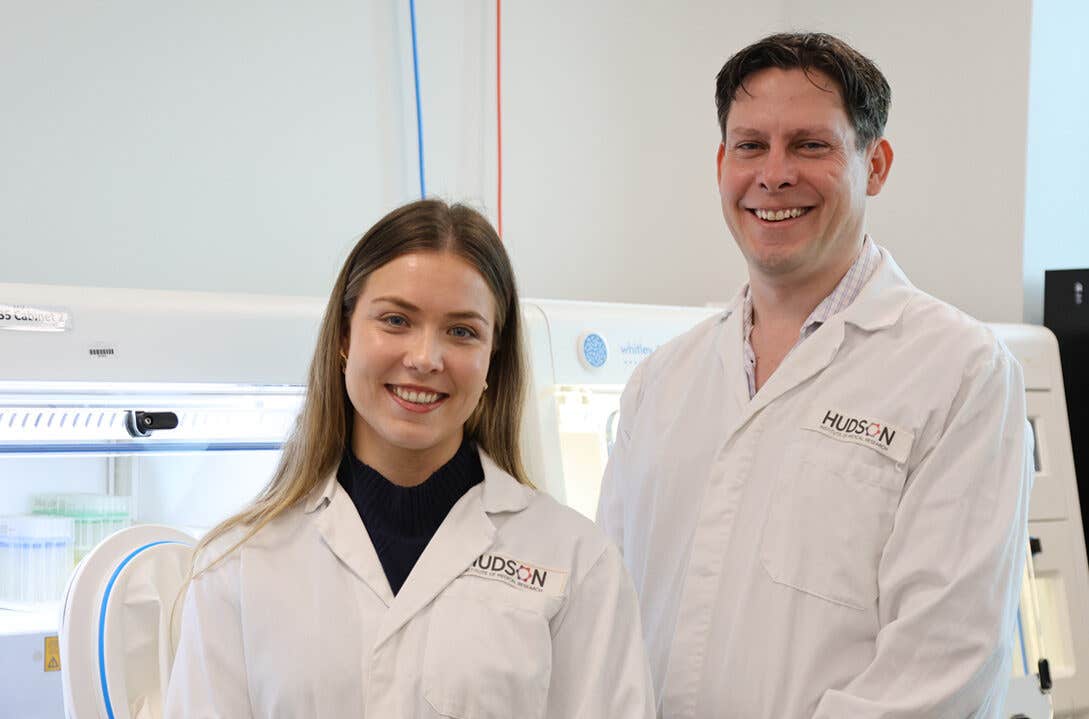The surprising science behind flatulence and gut health
Scientists from Monash University uncover a gut enzyme that turns hydrogen gas into a key player in digestion and gut health.

 Edited By: Joseph Shavit
Edited By: Joseph Shavit

L-R: Dr Caitlin Welsh and Associate Professor Sam Forster. (CREDIT: Hudson Institute of Medical Research)
It turns out there is more to gas than a sheepish laugh or a quick departure from a crowded room. Scientists from Monash University and the Hudson Institute of Medical Research have discovered how hydrogen gas, a major component of flatulence, plays an essential role in maintaining a healthy gut.
In a study posted in Nature Microbiology, Dr. Caitlin Welsh and colleagues described how an underexplored enzyme called Group B [FeFe]-hydrogenase helps gut bacteria thrive and keeps digestion ticking along.
"Most people expel about a liter of gas per day, and half of that is hydrogen," Welsh said. "But hydrogen is more than the gas behind flatulence—it's an invisible engine of gut health."
How the Study Worked
The researchers wanted to learn which microbial enzymes produce hydrogen gas in the human gut and how their activity varies in health and disease. From over 300 stool DNA samples and 78 RNA expression profiles, they discovered that the Group B [FeFe]-hydrogenase enzyme was by far the most abundant and active hydrogen-producing system in healthy individuals.
On average, this enzyme was found in roughly 62 percent of gut bacteria, specifically those belonging to the genus Bacteroides, which is infamous for breaking down complex carbohydrates. The researchers also looked at gut tissue samples from 42 donors and found that the enzyme was equally active in the intestinal lining, suggesting that its role isn't just limited to waste material but to where real digestion takes place.
What Makes This Enzyme Special
To confirm its activity, the scientists grew 19 gut bacterial species in fermentative conditions, the same that your gut uses to digest food. Thirteen strains carried genes for the Group B [FeFe]-hydrogenase enzyme, and nearly all of them generated detectable hydrogen gas—up to 3 percent in lab experiments. Bacteria lacking the enzyme made no hydrogen, confirming its essential role.
The enzyme works by recycling electrons through a molecule called ferredoxin during fermentation. Hydrogen production ramped up nearly 14 times when the scientists introduced particular compounds like pyruvate and coenzyme A, showing that the enzyme was using those chemical reactions to power gas production.
Hydrogen production halted completely when an inhibitor shut down a sister enzyme called pyruvate:ferredoxin oxidoreductase. That connection revealed the enzyme's unique connection to the fermentation process in the gut.
Even when bacteria were exposed to oxygen-like compounds they could use for respiration, hydrogen made up nearly 10 percent of their total energy output. This suggests that the enzyme remains active even when bacteria switch metabolic gears.
What Changes in Disease
One of the study's key findings was a difference between healthy individuals and Crohn's patients. Group B [FeFe]-hydrogenase genes were abundant in healthy guts, but their populations decreased by around 22 percent in Crohn's patients. Meanwhile, other hydrogen-producing enzyme types—especially those in the Group A1 [FeFe] and Group 4a [NiFe] families—became much more common.
"These patterns show that hydrogen cycling is fundamentally different in disease," co-senior author Professor Chris Greening, leader of the One Health Microbiology group at Monash University, said. "We don't yet know if this change leads to disease or is a consequence of it, but it's clear that hydrogen metabolism is connected to gut health."
The enzyme imbalance was also seen in diseases such as type 2 diabetes, liver cirrhosis, colorectal cancer, and atherosclerosis, showing that hydrogen metabolism can influence or reflect overall health problems.
A New View of Gut Microbes
Until now, most scientists believed that gut hydrogen was largely the product of bacteria of the Clostridia class. This study reversed that premise by showing that Bacteroides species, powered by the Group B [FeFe]-hydrogenase enzyme, are likely the actual workhorses. Not only do these bacteria generate hydrogen, but they also keep the electrons moving in the gut's complex microbial community.
Hydrogen doesn't just depart as flatulence—it's recycled by other microbes for energy. Some bacteria and archaea use hydrogen to synthesize molecules like methane or hydrogen sulfide. When this recycling process gets out of whack, it can affect the production of other molecules that regulate inflammation, metabolism, and even mood.
Why This Matters
Hydrogen has a bad reputation, but in your gut it's doing important work. It's affecting the microbial population, helping with digestion, and may even be influencing diseases distant from the stomach. "Gas production in the gut is a normal process," Professor Greening said. "Hydrogen is made in large amounts when bacteria break down food and then used by other microbes for energy."
Co-senior author and head of the Hudson Institute Microbiota and Systems Biology Laboratory Associate Professor Sam Forster said understanding such systems could eventually lead to better microbiome therapies. "By understanding what these systems do, it also opens up new possibilities for therapeutic interventions, some of which we haven't even thought of yet," he said.
For now, the team's work underscores that gut gas is not just a biological quirk—it's a significant sign of how the ecosystem inside you is functioning.
Practical Implications of the Research
This discovery gives scientists a clearer picture of how digestion works at a molecular level and why the makeup of gut gas is significant. Hydrogen metabolism can also be a new marker for gut health, allowing doctors to diagnose diseases like Crohn's earlier and more accurately.
It can also open up microbiome-based therapies that restore the normal balance between hydrogen-producing and hydrogen-consuming bacteria.
Further down the line, an understanding of this small enzyme could translate into more effective, gentler treatments for gastrointestinal disease—and a better understanding of what your gut gas is trying to tell you.
Research findings are available online in the journal Nature Microbiology.
Related Stories
- Fart gas may hold the key to a longer, healthier life
- Scientists find major link between gut health and arthritis
- Scientists reveal space travel's profound impact on gut health
Like these kind of feel good stories? Get The Brighter Side of News' newsletter.
Rebecca Shavit
Science & Technology Journalist | Innovation Storyteller
Based in Los Angeles, Rebecca Shavit is a dedicated science and technology journalist who writes for The Brighter Side of News, an online publication committed to highlighting positive and transformative stories from around the world. With a passion for uncovering groundbreaking discoveries and innovations, she brings to light the scientific advancements shaping a better future. Her reporting spans a wide range of topics, from cutting-edge medical breakthroughs and artificial intelligence to green technology and space exploration. With a keen ability to translate complex concepts into engaging and accessible stories, she makes science and innovation relatable to a broad audience.



